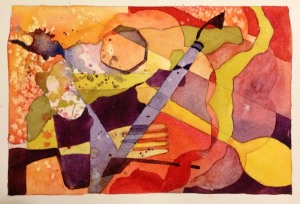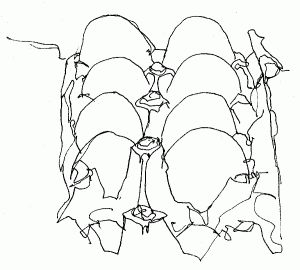The second throw of the die gave me yellow-green as a dominant color. Rules are meant to be broken or re-interpreted.

Glass Inkwells No. 5
The first throw of the die gave me an analogous color scheme with one complement. That means I use three colors adjacent to one another on the twelve hue color wheel plus one complement of any of those three hues. The traditional interpretation of that color scheme with yellow-green as the dominant color would be: Yellow-Green and the two colors on either side of Yellow-Green which would be Yellow and Green …. plus either Red, Red-Violet or Violet.
When I looked at my ink drawing I kept seeing the two large rectangles as Yellow-Green, almost a yellow. I didn’t want to use the colors on either side (yellow or green) in the painting. Instead, I used my dominant color Yellow-Green as the complement of the analogous trio Red-Violet, Violet and Blue-Violet. The rule that I try not to break is the rule of Being Flexible.
When I teach the Color Scheme Game Workshops, I am reminded that it is difficult for many people to break the rules. I encourage you to do so!
I have listed below the variations possible, and totally permissible, that I could have chosen when I threw the die this morning.
1. Traditional Combination …. Yellow, Yellow-Green, Green with either Red, Red-Violet or Violet
2. Yellow-Green, Green, Blue-Green with either Red-Violet, Red or Red-Orange
3. Yellow-Green, Yellow, Yellow-Orange with either Red-Violet, Violet or Blue-Violet
4. Red-Violet, Red, Red-Orange with Yellow-Green
5. Violet, Red-Violet, Red with Yellow-Green
6. Blue-Violet, Violet, Red-Violet with Yellow-Green
Remember that the purpose of playing the game is to sharpen your tools so that when you are painting your more ‘serious’ work, you can craft it more masterfully and have more confidence (and more fun) doing so.
Sketchbook drawing: Glass Inkwells No. 5 – drawn first with fountain pen filled with Noodler’s Black Ink followed by watercolor using a limited palette of Yellow-Green, Red-Violet, Violet and Blue-Violet.





















